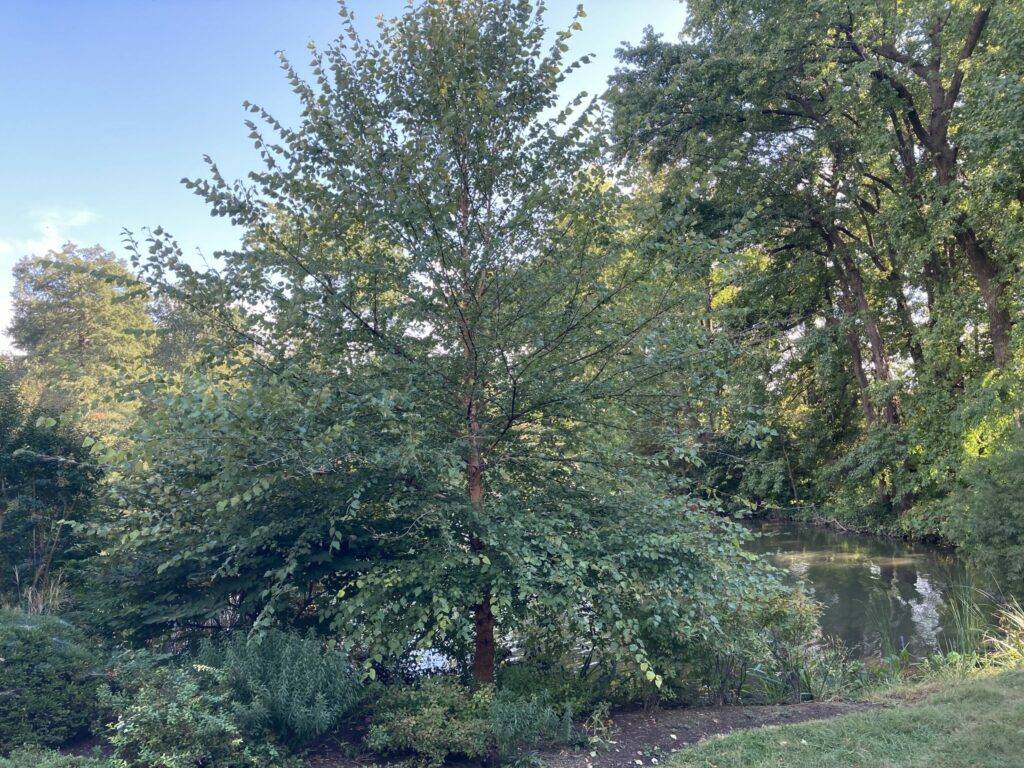By: Mark Halpin, Forestry Manager
It was shocking for me to realize that, after a year (!) of doing Tree of the Week, I have yet to discuss the River Birch (Betula nigra). One of the most beloved, widely planted trees in the eastern United States, one that many “normal” people can identify, it is a superstar. This is owing largely to legendary nurseryman Earl Cully of Jacksonville, Ill. (who unfortunately passed away in 2017 at the age of 90). Cully discovered an exceptionally beautiful specimen of River Birch growing in a St. Louis suburb back in the early 1970’s and used its genetic material to create the now world-famous ‘Heritage’ Birch, which he patented in 1979. If you see a River Birch planted in a landscape somewhere, there’s at least a 50% chance it is a ‘Heritage’ cultivar, distinguished by its cream colored, peeling bark.
Prior to this, the River Birch was almost persona non grata in the planted landscape, considered a coarse, weak and weedy tree along the lines of Black Willow or Cottonwood. The White Birch was the preferred species, considered more elegant (its logs are still popular holiday decor). With a native range that does not extend south of the Great Lakes, it was often severely stressed by the warm weather in our region, making it highly susceptible to Bronze Birch Borer. When the ‘Heritage’ cultivar arrived on the market to challenge its beauty without its pest susceptibility, the newcomer soon became everyone’s favorite yard tree. Similar cultivars of River Birch have since arrived (‘Dura-Heat’ being a popular one with even greater heat tolerance) and River Birch is now firmly established as a go-to, tried-and-true plant.
Luckily, public perception of the straight species River Birch has softened as well, and it too has become a popular species, particularly in parks. It is fast-growing, relatively pest-free, and very importantly, tolerant of compacted clay soil. Once established, River Birch are even somewhat drought tolerant, despite being riparian trees in the wild. They will always be their best in cool, moist soil though (if you have a high and dry location there are better options), and are one of those species that just look better with water nearby. A great yard tree certainly, but next to a stream or pond I can think of no species that looks more at home.
I can’t let River Birch go without one knock against it though; it is a messy tree. It sheds twigs constantly. They are usually small enough that they can be mowed over (or float away), but for those who desire a very tidy landscape…this is not your tree, unless playing “1000 pickup sticks” once or twice a week is your idea of fun. It also has a tendency to start dropping leaves once the intense heat of summertime is in full swing (June-July), but this is no cause for concern. Like other riparian species such as cottonwood and silver maple, it puts on a ton of thin, papery (not energy-intensive to grow) leaves when conditions are moist in springtime and starts “downsizing” its canopy when conditions dry out. Like a garden center that hires extra help during the spring flower craze and lays them off a month or two later, it’s just good business sense to make the most of spring’s bounty. Extra water may lessen this leaf drop, and will always be appreciated by a River Birch, but is by no means necessary. The tree will be just fine.
I often forget about River Birch, just because it’s so ubiquitous. But its popularity is well-deserved, and the more I think about it the more I like it. You can’t blame a tree for being overplanted. And it’s heartwarming to see all of those ‘Heritage’ Birch honoring the memory of Earl Cully, and a craze that he started with one gorgeous tree right here in St. Louis.




